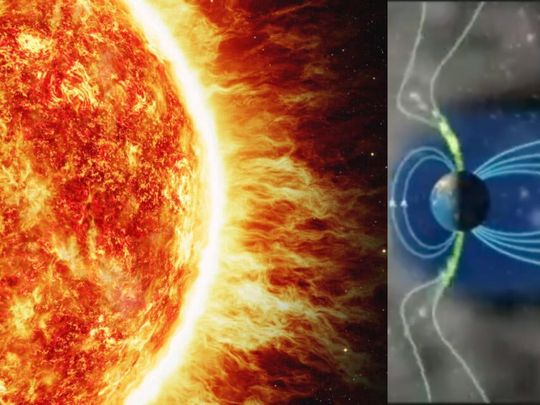
Since Wednesday (May 8, 2024), the sun has emitted powerful solar flares. It generated at least seven plasma outbursts, but did not disrupt life on earth as predicted by fear-mongers peddling the so-called "internet apocalypse".
It, however, caused Starlink internet service around the world to be “degraded”.
The phenomenon is the result of what scientists call coronal mass ejection (CME) — clouds of fiery plasma emitted from the sun, observed as a once-every-11-years cycle.
'Biggest in a long time'
The solar storm has been described as the “biggest in a long time.”
Friday (May 10, 2024) saw stunning exhibitions of the “Northern Lights,” or Aurora Borealis, illuminating the skies across the globe.
Observers marveled at the breathtaking display of vivid purple, green, yellow, and pink hues reported in numerous locations such as Germany, Switzerland, China, England, Spain, and beyond.
The US National Oceanic and Atmospheric Administration (NOAA) confirmed that CMEs did hit the Earth’s magnetic field and outer atmosphere.
Tech billionaire Elon Musk, whose Starlink satellite internet operator has thousands of satellites in low Earth orbit, said “Starlink satellites are under a lot of pressure, but holding up so far.”
For months, warnings about intense “solar storms” that could toast infrastructure on earth have increased. Digital chatter is awash with talk about how they would affect communication satellites, dislodge them from orbit, or bump into each other, and lose communication with earth.
While experts warn about its effect on the planet’s communication systems, there's no definitive proof of an impending “internet apocalypse”.
Apocalytic warnings about “months-long global internet shutdown” – supposedly from Nasa – had been peddled, apparently for views (and ads). Several YouTube video promoting this idea have amassed tens of thousands of views.
What really happened?
Cyclical solar activity have been observed recently:
Thursday (May 9): The US government issued its first severe geomagnetic storm watch in almost two decades – highlighting the possibility of multiple earth-directed coronal mass ejections and significant sunspot activity. Classified as a “G4 storm”, this event ranks as the second-highest grade in the US government's classification system for geomagnetic disturbances.
Friday (May 10, 2024): The National Oceanic and Atmospheric Administration (NOAA), issued a rare severe “geomagnetic storm” warning when a solar outburst reached Earth on Friday afternoon, hours sooner than anticipated.
The agency alerted operators of power plants and orbiting spacecraft, as well as the US Federal Emergency Management Agency (FEMA), to take precautions. In the US, Friday’s solar storm pushed the lights much farther south than normal.
Saturday (May 11): NOAA reported that the powerful solar storm put on an amazing skyward light show across the globe – but caused only “minor” disruptions to the electric power grid, communications and satellite positioning systems. Notably, NOAA upgraded the storm to G5, labeled as "extreme," marking the first such occurrence since October 2003.
Sunday (May 12): Nasa reported that the Sun emitted a strong solar flare, peaking at 12:26 p.m. ET on Sunday, May 12. NASA’s Solar Dynamics Observatory, which watches the Sun constantly, and captured an image of the event.
Each solar eruption, known as a coronal mass ejection (CME), can contain billions of tonnes of plasma and magnetic field from the sun’s outer atmosphere, or corona.
The flares seem to be associated with a sunspot that is 16 times the diameter of Earth, according to NOAA.
It is all part of the solar activity ramping up as the sun approaches the peak of its 11-year cycle.
No damage reported
Thankfully, the direst predictions never happened.
“That’s really the gift from space weather: the aurora,” Rob Steenburgh, a scientist with NOAA’s Space Weather Prediction Center, told AP. “For most people here on planet Earth, they won’t have to do anything.”
The US Federal Emergency Management Agency (FEMA) said that no region reported any significant impact from the storms.
The US Department of Energy (DoE) said Saturday it was not aware of any impact from the storms on electric customers.
Starlink service 'degraded'
SpaceX’s Starlink satellite internet service, however, said on its website Saturday (May 11) that service had been “degraded” and its team was investigating.
CEO Elon Musk wrote on the social platform X overnight that its satellites were “under a lot of pressure, but holding up so far.”
What happened in the past
An extreme geomagnetic storm in 2003 took out power in Sweden and damaged power transformers in South Africa.
Even when the storm is over, signals between GPS satellites and ground receivers could be scrambled or lost, according to NOAA.
But there are so many navigation satellites that any outages should not last long.
The most intense solar storm in recorded history, in 1859, prompted auroras in central America and possibly even Hawaii.
Fact check
Last year, following speculation about the probability of solar storms reaching a maximum, and posing a serious risk to the internet “for months”, Nasa issued a statement to dispell rumours surrounding a supposedly knock-on effects purportedly triggered by solar storms.
News of this possibility spread rapidly across social media platforms. Nasa, for its part, has not issued any warnings regarding an impending “internet apocalypse”.









